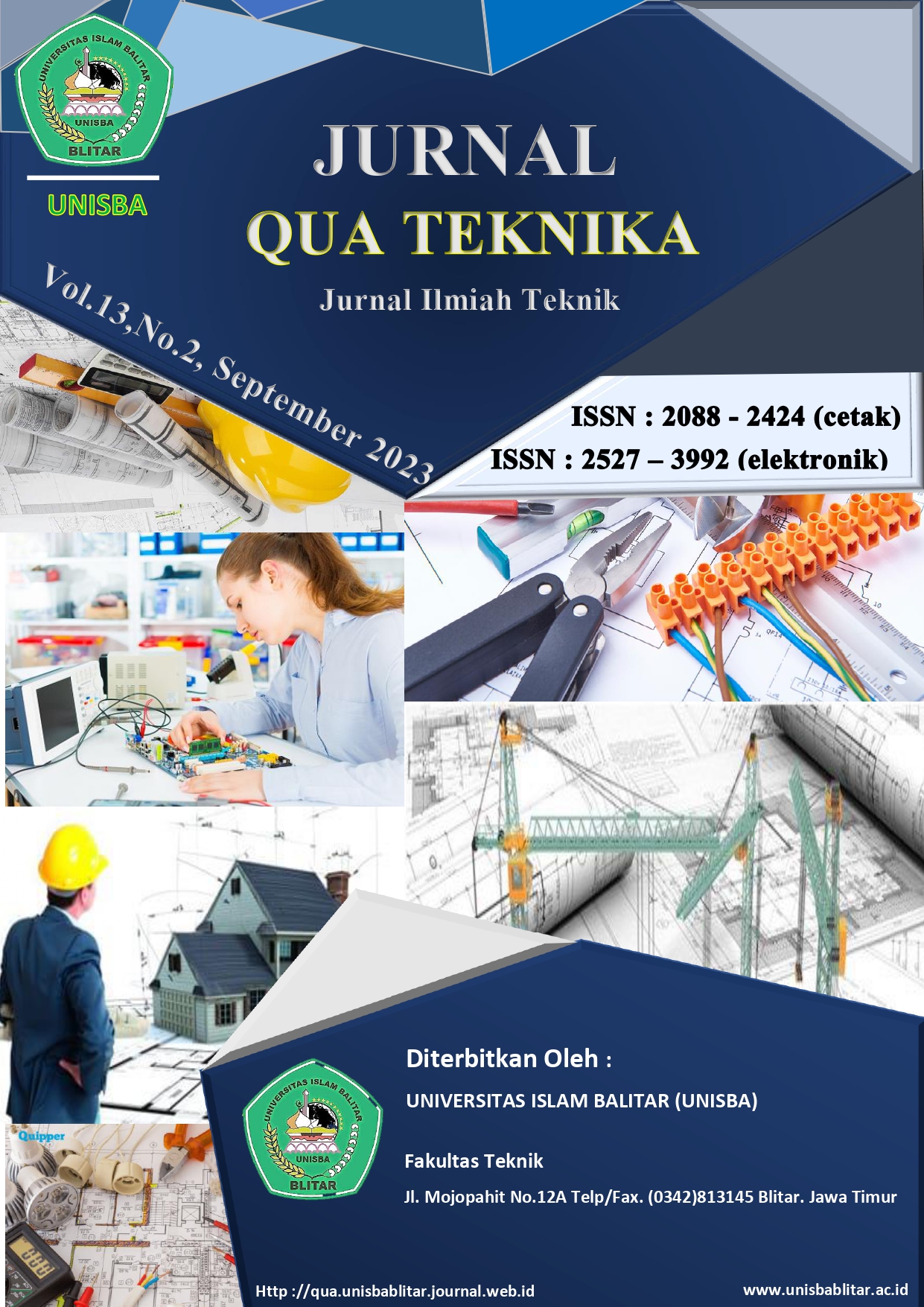PENGARUH RASIO L/D ANTARA LAPISAN MORTAR GEOPOLIMER BERBAHAN DASAR FLY ASH TERHADAP KUAT TEKAN BETON DENGAN SEAWATER CURING
DOI:
https://doi.org/10.35457/quateknika.v13i2.2840Keywords:
repair material, marine environment, L/D ratio, geopolymer mortar, compressive strength, seawater curingAbstract
ABSTRAK
The performance and durability of concrete in construction is essential to maintain the sustainability and protection of the material. Particularly in construction in marine environments, the attack of aggressive chemical compounds can affect concrete and accelerate deterioration. This research aims to improve the performance and durability of concrete in construction in marine environments by using additional protection methods such as Surface Applied Protection. One of the materials used is geopolymer mortar that uses fly ash as a base material. This study shows that geopolymer mortar contributes positively to the compressive strength and durability of concrete. The thickness of the geopolymer mortar layer affected the mechanical properties of the concrete, and 4 cm thick gave the highest compressive strength results. The addition of geopolymer mortar needs to be adjusted to the compressive strength of the concrete and pay attention to the layer thickness for optimal results.
Kata kunci: repair material, marine environment, L/D ratio, geopolymer mortar, compressive strength
References
[2] A. Abd El Fattah, I. Al-Duais, K. Riding, and M. Thomas, “Field evaluation of corrosion mitigation on reinforced concrete in marine exposure conditions,” Constr Build Mater, vol. 165, pp. 663–674, Mar. 2018, doi: 10.1016/j.conbuildmat.2018.01.077.
[3] M. Otieno, H. Beushausen, and M. Alexander, “Chloride-induced corrosion of steel in cracked concrete - Part I: Experimental studies under accelerated and natural marine environments,” Cem Concr Res, vol. 79, pp. 373–385, Jan. 2016, doi: 10.1016/j.cemconres.2015.08.009.
[4] R. A. Razak, N. A. Maliki, M. M. Al Bakri Abdullah, P. W. Ken, Z. Yahya, and S. Junaidi, “Performance of fly ash based geopolymer concrete in seawater exposure,” in AIP Conference Proceedings, American Institute of Physics Inc., May 2021. doi: 10.1063/5.0044260.
[5] “Concrete Repair and Maintenance Illustrated, PH Emmons”.
[6] Z. Zhang, X. Yao, and H. Wang, “Potential application of geopolymers as protection coatings for marine concrete III. Field experiment,” Appl Clay Sci, vol. 67–68, pp. 57–60, Oct. 2012, doi: 10.1016/J.CLAY.2012.05.008.
[7] Z. Zhang, X. Yao, and H. Zhu, “Potential application of geopolymers as protection coatings for marine concrete I. Basic properties,” Appl Clay Sci, vol. 49, no. 1–2, pp. 1–6, 2010, doi: 10.1016/j.clay.2010.01.014.
[8] A. Leonard Wijaya, J. Jaya Ekaputri, and Triwulan, “Factors influencing strength and setting time of fly ash based-geopolymer paste,” in MATEC Web of Conferences, EDP Sciences, Dec. 2017. doi: 10.1051/matecconf/201713801010.
[9] J. Satria, A. Sugiarto, and D. Hardjito, “Effect of Variability of Fly Ash Obtained from the Same Source on the Characteristics of Geopolymer.”
[10] A. Widayanti, R. Asih Aryani Soemitro, H. Suprayitno, and J. Jaya Ekaputri, “Characterization and compressive strength of fly ash based-geopolymer paste,” in MATEC Web of Conferences, EDP Sciences, Aug. 2018. doi: 10.1051/matecconf/201819501023.
[11] Antoni, S. W. Wijaya, and D. Hardjito, “Compressive strength of geopolymer based on the fly ash variation,” in Materials Science Forum, Trans Tech Publications Ltd, 2016, pp. 98–103. doi: 10.4028/www.scientific.net/MSF.841.98.
[12] Z. Zhang, X. Yao, and H. Zhu, “Potential application of geopolymers as protection coatings for marine concrete I. Basic properties,” Appl Clay Sci, vol. 49, no. 1–2, pp. 1–6, 2010, doi: 10.1016/j.clay.2010.01.014.
[13] F. Tittarelli, A. Mobili, C. Giosuè, A. Belli, and T. Bellezze, “Corrosion behaviour of bare and galvanized steel in geopolymer and Ordinary Portland Cement based mortars with the same strength class exposed to chlorides,” Corros Sci, vol. 134, pp. 64–77, Apr. 2018, doi: 10.1016/J.CORSCI.2018.02.014.
[14] J. Kwasny, T. A. Aiken, M. N. Soutsos, J. A. McIntosh, and D. J. Cleland, “Sulfate and acid resistance of lithomarge-based geopolymer mortars,” Constr Build Mater, vol. 166, pp. 537–553, Mar. 2018, doi: 10.1016/j.conbuildmat.2018.01.129.
[15] L. Novia Halim and J. Jaya Ekaputri, “The Influence of Salt Water on Chloride Penetration in Geopolymer Concrete.”
[16] M. F. Alnahhal, U. J. Alengaram, M. Z. Jumaat, B. Alsubari, M. A. Alqedra, and K. H. Mo, “Effect of aggressive chemicals on durability and microstructure properties of concrete containing crushed new concrete aggregate and non-traditional supplementary cementitious materials,” Constr Build Mater, vol. 163, pp. 482–495, Feb. 2018, doi: 10.1016/j.conbuildmat.2017.12.106.
Downloads
Published
Issue
Section
License
Authors who publish with this journal agree to the following terms:
- Copyright on any article is retained by the author(s).
- Author grant the journal, right of first publication with the work simultaneously licensed under a Creative Commons Attribution License that allows others to share the work with an acknowledgement of the work’s authorship and initial publication in this journal.
- Authors are able to enter into separate, additional contractual arrangements for the non-exclusive distribution of the journal’s published version of the work (e.g., post it to an institutional repository or publish it in a book), with an acknowledgement of its initial publication in this journal.
- Authors are permitted and encouraged to post their work online (e.g., in institutional repositories or on their website) prior to and during the submission process, as it can lead to productive exchanges, as well as earlier and greater citation of published work.
- The article and any associated published material is distributed under the Creative Commons Attribution-ShareAlike 4.0 International License
Deprecated: json_decode(): Passing null to parameter #1 ($json) of type string is deprecated in /home/ejournal.unisbablitar.ac.id/public_html/plugins/generic/citations/CitationsPlugin.php on line 68










